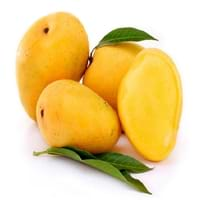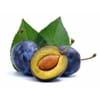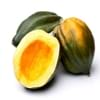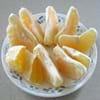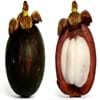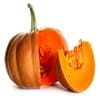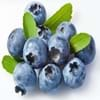Health Benefits
Good for diabetics, Improves well-being, Miraculin/miracle fruit makes sour things taste sweet
Cancer prevention, Cures fatigue, Heart care, Prevents strokes
General Benefits
Has taste modifying effect
Anti oxidant properties, Boosts immune system, Controls blood pressure, Digestive aid, Improves eye vision, Maintains healthy cholesterol level
Skin Benefits
NA
Anti-aging benefits, Brightens and lightens complexion, Skin cleansing, Skin rejuvenation, Treatment of acne, Treatment of blackheads, Treatment of dark spots
Hair Benefits
NA
Good conditioner, Prevents hair loss, Treatment of dandruff
Allergy Symptoms
Itching, Skin rash
Abdominal pains, Breathing difficulty, Diarrhea, Runny nose, Sneezing, Swelling of mouth, tongue or lips, Watery eyes
Side Effects
Changes taste of food eaten after this fruit, Coagulation
Increase in blood sugar level, Diarrhoea, Weight gain
Best Time to Eat
As a snack in the late afternoon, Eat the fresh ones, avoid mixing with any other foods, don't eat after meal., Morning time (before lunch)
Don't consume at night and before bed, Eat the fresh ones, avoid mixing with any other foods, don't eat after meal., Morning time (before lunch)
Protein to Carb Ratio
Not Available
Vitamin A (Retinol)
Not Available
Vitamin B1 (Thiamin)
Not Available
Vitamin B2 (Riboflavin)
Not Available
Vitamin B3 (Niacin)
Not Available
Vitamin B5 (Pantothenic Acid)
Not Available
Vitamin B6 (Pyridoxin)
Not Available
Vitamin B9 (Folic acid)
Not Available
Vitamin C (Ascorbic Acid)
Vitamin K (Phyllochinone)
Not Available
Lutein+Zeaxanthin
Not Available
Water Content
Not Available
Calories in Fresh Fruit with Peel
Not Available
Not Available
Calories in Fresh Fruit without Peel
Not Available
Calories in Frozen Form
Not Available
Calories in Dried Form
Not Available
Calories in Canned Form
Not Available
Calories in Juice
Not Available
Calories in Jam
Not Available
Calories in Pie
Not Available
Season
Monsoon
Spring, Summer
Varieties
Gymnema Sylvestre and Thaumatococcus Daniellii
Alphonso, Valencia Pride, Badami, Chaunsa, Nam Dok Mai, Glenn, Sindhri, Madame Francique, Kesar and Keitt
Color
Dark red
Orange, Red, Yellow
Inside Color
Greyish-white
Yellow
Origin
West Africa
Southern Asia
Soil Type
Well-drained
Clay, Loam, Sand
Climatic Conditions
Rainfall
Humid, Warm to hot climate
Facts about
- The name 'Miracle' because of the magical experience you get after eating it.
- When you have lemon after eating this fruit, it tastes sweet as if it is added with sugar.
- It is also used as natural sweetener.
- A mango tree can bear fruits even after the age of 300 years.
- Height of a mango tree can be as high as 100 feet.
- In India, mango is known as a symbol of love. Also, a mango basket is considered as the sign of friendship.
Other Countries
NA
Bangladesh, Brazil, China, Indonesia, Mexico, Nigeria, Pakistan, Philippines, Thailand
Top Importer
Not Available
United States of America
Top Exporter
United States of America
Mexico
Botanical Name
Synsepalum Dulcificum
Mangifera Indica
Synonym
Miracle Berry, Miraculous Berry and Sweet Berry
Not Available
Subkingdom
Tracheobionta
Tracheobionta
Division
NA
Magnoliophyta
Subclass
Asteridae
Rosidae
Order
Ericales
Sapindales
Family
Sapotaceae
Anacardiaceae
Genus
Synsepalum
Mangifera
Species
S. dulcificum
M. indica
Generic Group
Not Available
Cashew
Difference Between Miracle fruit and Mango
We might think that Miracle fruit and Mango are similar with respect to nutritional value and health benefits. But the nutrient content of both fruits is different. Miracle fruit and Mango Facts such as their taste, shape, color, and size are also distinct. The difference between Miracle fruit and Mango is explained here.
The amount of calories in 100 gm of fresh Miracle fruit and Mango with peel is Not Available and Not Available and the amount of calories without peel is Not Available and 60.00 kcal respectively. Thus, Miracle fruit and Mango belong to Low Calorie Fruits and Low Calorie Fruits category.These fruits might or might not differ with respect to their scientific classification. The order of Miracle fruit and Mango is Ericales and Sapindales respectively. Miracle fruit belongs to Sapotaceae family and Mango belongs to Anacardiaceae family. Miracle fruit belongs to Synsepalum genus of S. dulcificum species and Mango belongs to Mangifera genus of M. indica species. Beings plants, both fruits belong to Plantae Kingdom.

